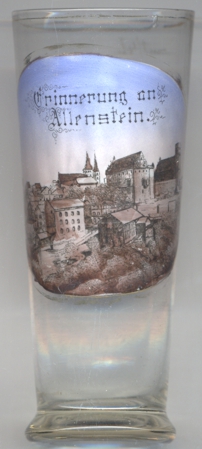

|
| POLSKA | POLAND |
| województwo: Warmińsko-Mazurskie | voivodship: Warmia and Masuria |
| miasto na prawach powiatu: Olsztyn | city: Olsztyn |
 Olsztyn (until 1945: Allenstein) is situated at an elevation of 90 m on the river Łyna (Alle). Olsztyn is the capital
of the voivodship Warmia and Masuria, seat of the Catholic archdiocese of Warmia and of the Protestant (Augsburg Confession)
diocese of Masuria. The municipality has a population of about 175,000 (2014).
Olsztyn (until 1945: Allenstein) is situated at an elevation of 90 m on the river Łyna (Alle). Olsztyn is the capital
of the voivodship Warmia and Masuria, seat of the Catholic archdiocese of Warmia and of the Protestant (Augsburg Confession)
diocese of Masuria. The municipality has a population of about 175,000 (2014).
Allenstein castle was founded in 1346 by the chapter of the bishopric Ermland (Warmia). The town below the castle was founded
by Johannes von Leysen who on 13 October 1353 had obtained a settlement privilege from the bishopric. The settlement
received the privileges of a town in the same year. Allenstein was the seat of one of the administrative divisions
of the Prince-Bishopric of Warmia that were subject to the bishopric chapter: Allenstein, Mehlsack (now Pieniężno)
and Frauenburg (now Frombork); the chapter of the bishopric resided in Frauenburg castle while the bishop's
residence since 1350 was in Heilsberg (today Lidzbark Warmiński). Canon, and famous astronomer, Nikolaus Kopernikus
was administrator of the castle from 1516 until 1519; an astronomic table for the calculation of equinoxes, painted on a
wall of the castle cloister still gives evidence of his work here. Following the first Partition of Poland-Lithuania in 1772
(see map) Warmia became part of the Kingdom
of Prussia. Together with Königsberg (now
Калининград (Kaliningrad), RUS)
and Gumbinnen (now Гусев/Gusew, RUS), Allenstein in 1905 became one of the three administrative
divisions of East Prussia. After World War I and the Treaty of Versailles (1919), a referendum was held, which ended in
 Olsztyn/Allenstein castle [right] was built between 1346 and 1353, made up of
one wing to the north-east of the courtyard. The castle was surrounded by a line of fortifications and a ditch which lead
to the Łyna River with a bascule bridge. The south-east wing of the castle was built in the 15th century. The tower
from the 14th century, was placed in the eastern corner of the courtyard, and reconstructed in the early 16th century,
giving the castle a circular look in a square formation; the tower having 40 metres in height. During the reconstruction of
the tower, the castle's fortifications were raised to 12 metres in height. By this, the castle became a major bastion
located on the borders of Olsztyn, securing its entrance. The castle belonged to the Bishops of Warmia (Ermland), and until
1454 was protected by the Teutonic Order. In the years of 1516 to 1521, the administrator of the castle was Nicolaus
Copernicus. Over time the castle's militaristic importance diminished. In 1758, a direct entrance from Olsztyn was built,
and a palace wing was built; the expansion meant that many of the fortifications were deconstructed. By the First Partition
of Poland in 1772 (see map), Warmia was merged with the surrounding parts of East Prussia and
annexed by the Kingdom of Prussia; the properties of the Archbishopric of Warmia were secularized by the Prussian state.
In 1845, the bridge connecting the castle to the town was replaced with a levee, the ditch was removed. Between 1901 and
1911, the castle underwent various renovations; this included the change in floor levels, and arched windows in the
cloister. The castle became the Museum of the Warmian-Masurian Voivodeship in 1946; apart from various exhibitions the
museum also hosts the Olsztyn Artistic Summer ('Olsztynskie Lato Artystyczne').
Olsztyn/Allenstein castle [right] was built between 1346 and 1353, made up of
one wing to the north-east of the courtyard. The castle was surrounded by a line of fortifications and a ditch which lead
to the Łyna River with a bascule bridge. The south-east wing of the castle was built in the 15th century. The tower
from the 14th century, was placed in the eastern corner of the courtyard, and reconstructed in the early 16th century,
giving the castle a circular look in a square formation; the tower having 40 metres in height. During the reconstruction of
the tower, the castle's fortifications were raised to 12 metres in height. By this, the castle became a major bastion
located on the borders of Olsztyn, securing its entrance. The castle belonged to the Bishops of Warmia (Ermland), and until
1454 was protected by the Teutonic Order. In the years of 1516 to 1521, the administrator of the castle was Nicolaus
Copernicus. Over time the castle's militaristic importance diminished. In 1758, a direct entrance from Olsztyn was built,
and a palace wing was built; the expansion meant that many of the fortifications were deconstructed. By the First Partition
of Poland in 1772 (see map), Warmia was merged with the surrounding parts of East Prussia and
annexed by the Kingdom of Prussia; the properties of the Archbishopric of Warmia were secularized by the Prussian state.
In 1845, the bridge connecting the castle to the town was replaced with a levee, the ditch was removed. Between 1901 and
1911, the castle underwent various renovations; this included the change in floor levels, and arched windows in the
cloister. The castle became the Museum of the Warmian-Masurian Voivodeship in 1946; apart from various exhibitions the
museum also hosts the Olsztyn Artistic Summer ('Olsztynskie Lato Artystyczne').
[https://de.wikipedia.org/wiki/Olsztyn, https://en.wikipedia.org/wiki/Olsztyn;
https://en.wikipedia.org/wiki/Johannes_von_Leysen; https://de.wikipedia.org/wiki/Fürstbistum_Ermland; https://de.wikipedia.org/wiki/Woiwodschaft_Ermland-Masuren;
https://en.wikipedia.org/wiki/Olsztyn_Castle, https://en.wikipedia.org/wiki/Warmia]
![[scale]](lineal.jpg)